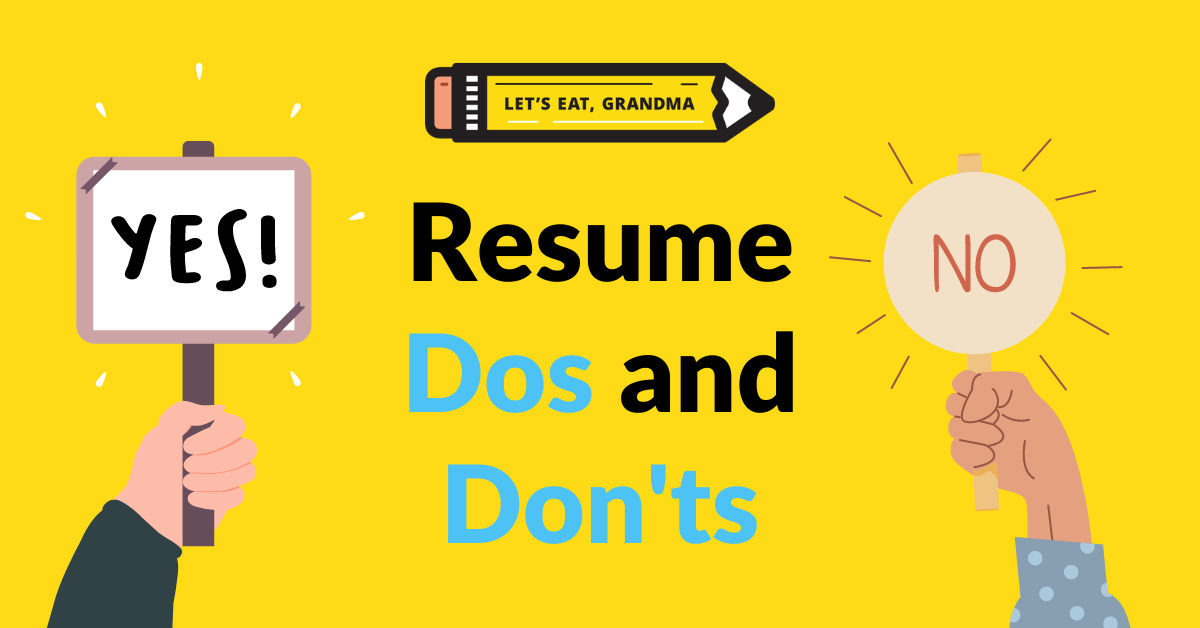This, Not That: 19 Resume Dos and Don’ts for Landing an Interview

There’s some great resume advice out there and some that’s… not so great. Some short and simple resume dos and don’ts to help you land more interviews.
By: Grace Mitchell | Contributor for Let’s Eat, Grandma
Need some resume pointers? Whether you’re a resume superstar looking for a quick checklist, or you’re a veteran player who’s been out of the resume-writing game for a while, we’ve got you! Here’s a quick list of our top resume dos and don’ts so you can make your resume a home run.
Note: As with all resume-writing advice, it’s worth mentioning that your mileage may vary. Every job search is different so not every piece of advice will apply to your unique situation. However, the resume dos and don’ts given here are fairly universal.
Ready for more job search help?
Sign up for a free Senior Writer Resume Critique to see what's holding you back from landing interviews. One of our top professional resume writers will give you personalized feedback on the top 3 items you can improve based on our expert practices!
Also, if you need some more comprehensive resume advice, check out our blog on building your resume from scratch or ask our writers for a free tailored resume critique!
Resume Dos
Consider beefing up your resume with some solid suggestions, like:
Use a strong summary

Resume got you stumped? Our comprehensive resume dos and don’ts will help. Photo by Afif Kusuma on Unsplash
Your summary of qualifications sits at the very top of your resume beneath your header, making it a crucial part of a recruiter’s initial impression of you. You should use this section to highlight your most laudable and relevant achievements and give an overview of your career highlights. This is especially important if you’re transitioning into a new career.
Consider a key achievements section
If you’re 20+ years into your field, a key achievements section allows you to summarize the most important aspects of your career thus far. This section should use concrete metrics to summarize senior-level career highlights. However, if you’re not at this level, your resume might not benefit from including this.
Decide if you need 1 or 2 pages
You may have heard that your resume should only be one page long. However, if you have a lot of relevant experience, two pages of content can be a great option. As with the key achievements section, though, it’s up to you to decide whether if you feel your career has been extensive enough to warrant two pages, as your resume should still be as short as possible. To help you decide whether your resume should be one or two pages, check out this flowchart as a starting point.
Include a cover letter
Regardless of what position you’re applying for, it’s valuable to include a cover letter (unless the job posting specifies no cover letters, of course). A well-written cover letter is your opportunity to set yourself apart from the competition and make it clear why you think you’re a great fit for the job. This is a valuable document, so don’t let a bit of extra work scare you away from writing one!
Choose an appropriate font and font size
The font and font size you use in your resume can make or break its readability. Plus it can help communicate your personal brand. Be sure to use an easy-to-read font that’s consistent across different versions of Word (like Arial or Georgia). Set your font size at anywhere from 10-12pt for the body of your resume, depending on how wide the font is. Your name and headings can be larger.
Use accomplishment-based bullet points

Bullet points on your resume should focus on accomplishments, not everyday tasks. Photo by Miguelangel Miquelena on Unsplash
Your resume shouldn’t read like a job description! Your recruiter wants to know what unique skills you had at your previous jobs, so use accomplishment-based bullet points to strut your stuff. Leading with an active verb (more on that below) and using specific metrics and results better communicates what a capable and passionate worker you are to recruiters.
Use active verbs
Each bullet point in your resume should start with an active verb to describe your achievements. Not only does this make your resume more engaging to read, but it also more accurately shows off your accomplishments. Which sounds better to you? “Responsible for” or “Managed”? Active verbs engage the recruiter’s attention in a way flat resume cliches can’t.
Use strong adjectives
Your resume should use strong adjectives to more richly convey your skills and experiences. Words like “passionate,” “confident,” and “resourceful” give a greater depth to your bullet points and draw recruiters into your career story. Be careful to avoid overused or bland adjectives, though, as these can curb your recruiter’s interest.
Tailor it to every job description and optimize for ATS
You should be editing your resume for each job you apply for, even if they’re similar positions. While this does take a bit of time, tailoring your resume makes it easier for the recruiter to see that you have the most important qualifications in the job description, which makes it more likely that you’ll land an interview. Your resume should also be optimized for compatibility with Applicant Tracking Systems (ATS), so make sure it’s formatted simply and cleanly, and remember that a human should want to read it as well.
Resume Don’ts
There are, unfortunately, some ways to drag down an otherwise great resume. In order to improve your resume, you should avoid these:
Use an objective statement

A modern resume doesn’t include an objective statement. Photo by Thought Catalog on Unsplash
This is our least favorite resume section. Objective statements don’t add anything to your resume that the recruiter won’t already know. Of course your objective is to get a job – why else are you applying for one? Leave this useless section in the past where it belongs, and consider including a summary of qualifications instead.
Use cliches
You’re better than cliches! Besides, your recruiter has probably read enough cliche-filled resumes to make their blood boil, and including some in yours (like “team player” or “works well independently”) could give them a reason to reject your application. Try rewording any overused phrases in your resume to better convey the unique skills you have to offer.
Go over 2 pages
Even if you’ve had a long career, you don’t need more than two pages! Your resume should provide a quick summary of your most notable career highlights, not give a detailed play-by-play of all the work you’ve ever done. Be sure to limit your bullet points to three to six per job, and leave out any information that isn’t relevant to the job you’re applying for.
Add anything irrelevant to the job, like hobbies
Listen, we hope you have activities you really enjoy outside of work; work-life balance is important! However, part of work-life balance is leaving the stuff that doesn’t relate to your career off your resume. Focus on getting your foot firmly in the door first, and then recruit for your roller derby team once you’re secure in your new job!
Add unnecessary skills
Speaking of irrelevant information, your resume is valuable real estate, and there isn’t room to include any skills that don’t matter for this job. You only have 1-2 pages to impress your recruiter, so make them count! Don’t fluff up your skills section with obsolete, obvious, or unrelated skills. Instead, load up your resume with relevant and transferable skills and experiences, leaving everything else for your LinkedIn profile.
Over-optimize for ATS or submit a plain text resume
Applicant Tracking Systems are huge in the hiring field right now. However, at the end of the day, an ATS is still just a tool that a recruiter uses, not an automated rejection machine. There will still be a person reading your resume in that ATS, and they’re the one you should be trying to impress. Don’t overload your resume with a barrage of keywords, and please please please don’t submit your resume in the plain text file format!
Include a photo

Never put a photo on your resume. Photo by Marc Kleen on Unsplash
Including your photo in your resume is just never a good idea. Not only can it throw off your recruiter’s ATS, but it will increase the likelihood of your recruiter finding a reason not to hire you. A photo is a potential discrimination trigger, it doesn’t tell the recruiter anything to help them hire you, and it wastes valuable, limited space that should be used for your relevant accomplishments.
Let your qualifications speak for themselves instead! Your professional headshot is a great thing to include in your LinkedIn profile, but please don’t put one in your resume.
Use graphics or fancy design elements
It may be tempting to try to stand out by making an extra-creative resume. However, using fancy resume templates and designs can make it difficult for an ATS to properly parse your resume, make it harder for the recruiter reading it to quickly find your qualifications, and give you less room to include necessary information. Unless you’re a graphic designer or other creative, it’s best to keep your design simple. This will not help you stand out from the competition.
Copy/paste your whole resume on LinkedIn
Your resume should give recruiters a good idea of your career story just like your LinkedIn profile, but they’re two separate mediums. LinkedIn is best used to tell your full story with plenty of supplementary details that it would be unwise to include in your resume. You shouldn’t simply copy the summary and bullets from your resume into your LinkedIn profile, but rather use all the extra features and extra space that the platform has to offer.
And, snce recruiters have the option to “See more,” your LinkedIn profile is the ideal place to mention the volunteer hours you do at your local synagogue, your ultimate frisbee league, or other possible points of connection.
List your full address
It’s 2022: Your recruiter isn’t going to mail you an interview request! Plus, if you post your resume online, broadcasting the location of your home to countless strangers can put your security and privacy at risk. Include just your city and state, or your current city/state and the one you’d be commuting and relocating to if the job is in another location.
Going for the Gold

Following these resume dos and don’ts will ensure your resume is a hit. Photo by krakenimages on Unsplash
Your resume (along with the art of networking) is your chance to make a great first impression with your recruiter and hiring manager. Following these simple resume dos and don’ts can help you touch up your resume so that you can score an interview for the job of your dreams. Now get out there and show those recruiters what you’re made of!
Ready for more job search help?
Sign up for a free Senior Writer Resume Critique to see what's holding you back from landing interviews. One of our top professional resume writers will give you personalized feedback on the top 3 items you can improve based on our expert practices!
